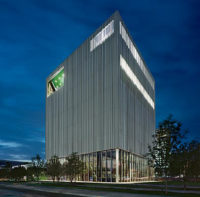Continuing Education: Dee and Charles Wyly Theatre
Dramatically reconfigurable: A machinelike hall depends on inventive structural and acoustical solutions.
Dallas, Texas
When architects from REX/OMA conceived Dallas’s Dee and Charles Wyly Theatre, they envisioned the ultimate flexible performance space. The building is designed so that the theater’s interior can be radically reconfigured by a small crew of stagehands from a proscenium layout to a thrust-stage arrangement or a flat-floor room in just a few hours. Blackout shades can be pulled up to reveal its three facades of glass and to open the chameleonlike, 109-by-94-foot hall to the city. Auxiliary programmatic elements are piled above and below (but mostly above) the ground-level performance chamber to create a 132-foot-tall tower. Instead of the horizontal layout more typical of theaters, functions are stacked “like a giant game of Jenga,” says John Coyne, a principal of Theatre Projects, the Wyly’s theater consultant.
 To earn one AIA learning unit, including one hour of health, safety, and welfare (HSW) credit, read each of this month’s Project Portfolio stories and accompanying sidebars. For learning objectives and to take the test click here.
To earn one AIA learning unit, including one hour of health, safety, and welfare (HSW) credit, read each of this month’s Project Portfolio stories and accompanying sidebars. For learning objectives and to take the test click here.An unconventional structure, with no interior or corner columns, allows for the theater’s flexibility, as well as its transparency and verticality. The tower rests on six perimeter supercolumns, four of which incline dramatically, and a perimeter shear wall. A belt truss that spans from levels 4 through 7, augmented by a series of smaller interior trusses, completes the building’s frame.
Within the Wyly’s performance chamber, the project team hoped to create acoustical conditions that would provide a short reverberation time in the range of 0.8 and 1.4 seconds. Reverberation — the persistence or lingering of sound within a space after the sound source has stopped — is considered less desirable for drama, which depends on the intelligibility of speech, while longer reverberation is preferred for music.
But creating the acoustical qualities best-suited to dramatic productions was complicated by the Wyly’s programmatic and structural gymnastics. Since reverberation time is inversely proportional to the amount of absorptive finishes (and directly proportional to a room’s volume), designers needed to add material that would dissipate acoustical energy. But with three walls of glass, and stage and seating configurations in constant flux, there were few fixed surfaces that they could treat. One of the few available areas was the chamber’s ceiling. Here, within a grid that accommodates catwalks and equipment for lighting, sound, and rigging, the project team installed acoustical reflectors of smooth fiberglass board curved to help distribute sound evenly to the seating below. They applied the same material to fly-space walls.
Intelligibility is not only dependent on controlling reverberation. Sounds from outside the performance space can detract from the audience’s experience. And at Wyly, which is near a highway and under an airport flight path, there was plenty of such potentially distracting noise to contend with.
Dampening the low-frequency sounds from traffic and airplanes, while maintaining the transparency integral to the building’s parti would have been fairly straightforward with an envelope of two glass walls separated by an air space several feet wide, explains acoustician Renz van Luxemburg, a principal consultant at engineering firm DHV. However, budget and architectural constraints required that the building envelope provide sufficient sound attenuation within the depth of a typical insulated glazing unit (IGU).
Working with facade consultant Front, DHV developed a 2 3⁄8-inch glass assembly that combines clear and low-iron glazing and sandwiches a 1-inch air space between exterior and interior laminated lites. Each lamination includes an acoustical interlayer with more rigidity than a typical PVB (polyvinyl butyral) interlayer. This stiffness, and the air space, which is about twice as large as that in a standard IGU, along with an asymmetrical buildup of glass of different thicknesses, help dampen sound transmission, says Brian Guerrero, Front project manager.
A standard IGU has a sound transmission class (STC) rating of about 35, depending on the frequency range. An STC is a measure of how well a building component, such as a wall, partition, or window, attenuates airborne sound. At Wyly, the IGU, along with its aluminum frame, has a significantly improved STC of about 50. This level of insulation “won’t eradicate the sound of a 747 completely,” says Guerrero. “But it will considerably mitigate it.”


